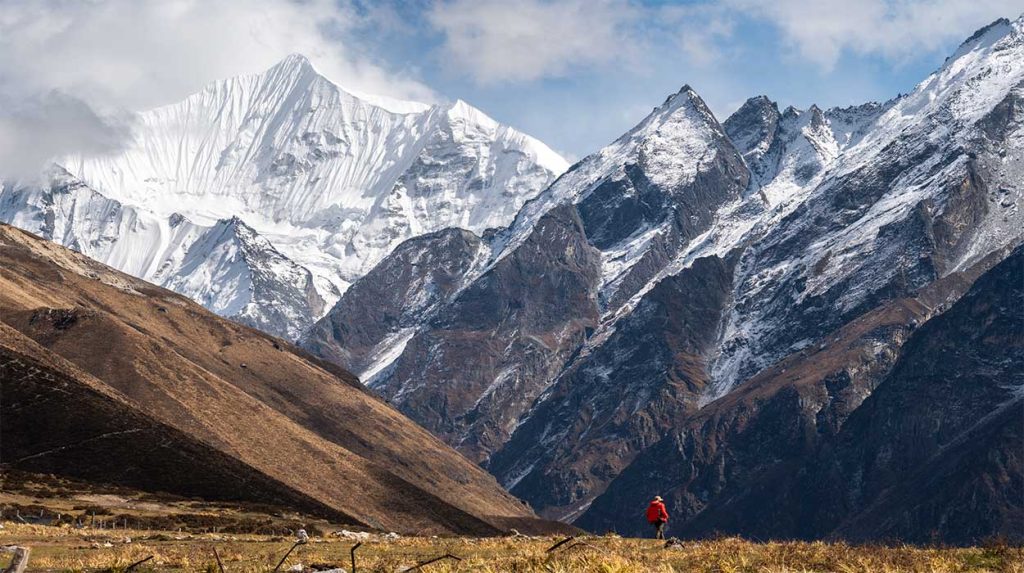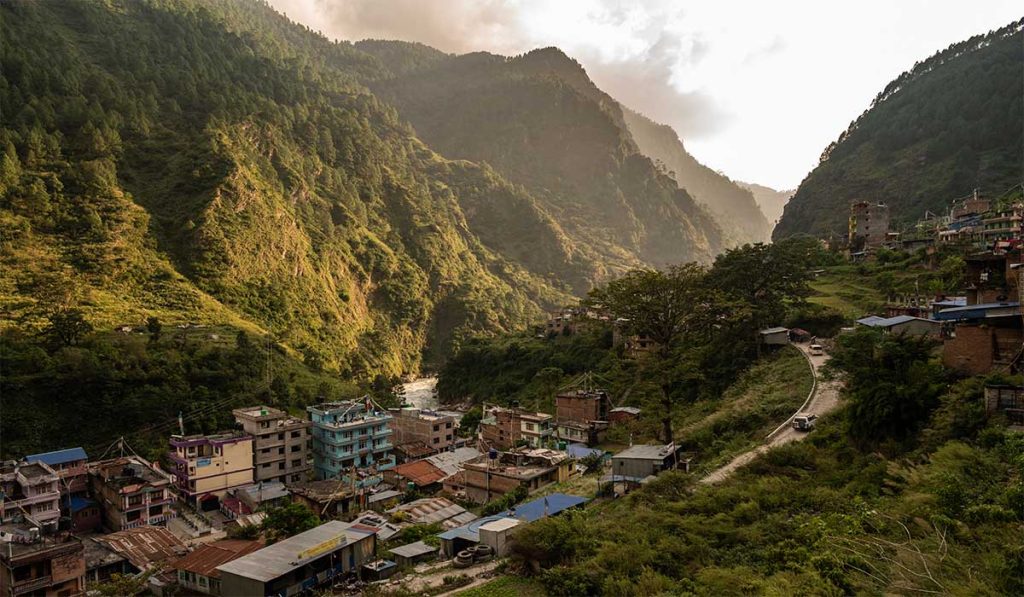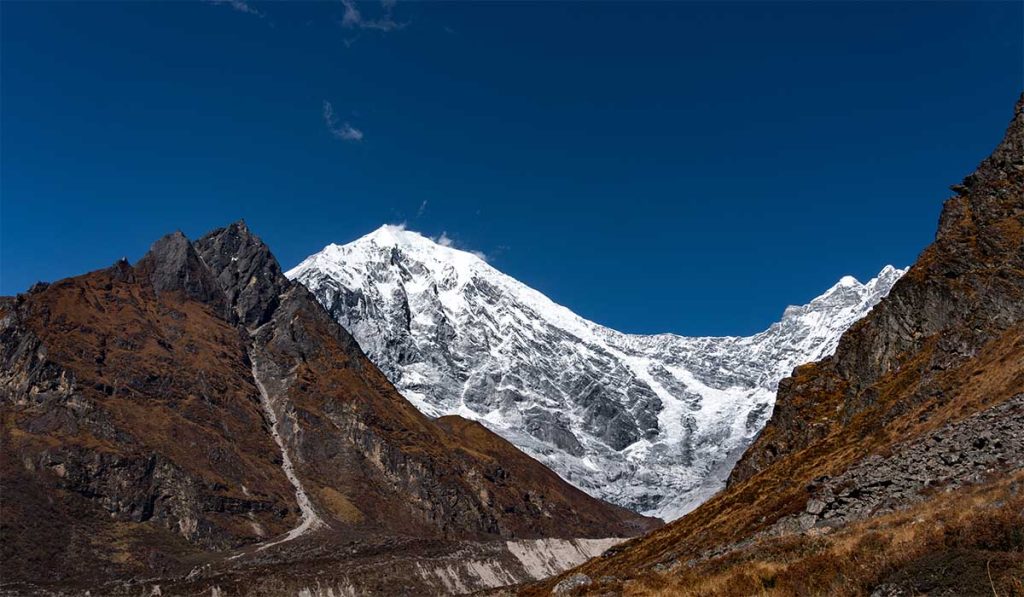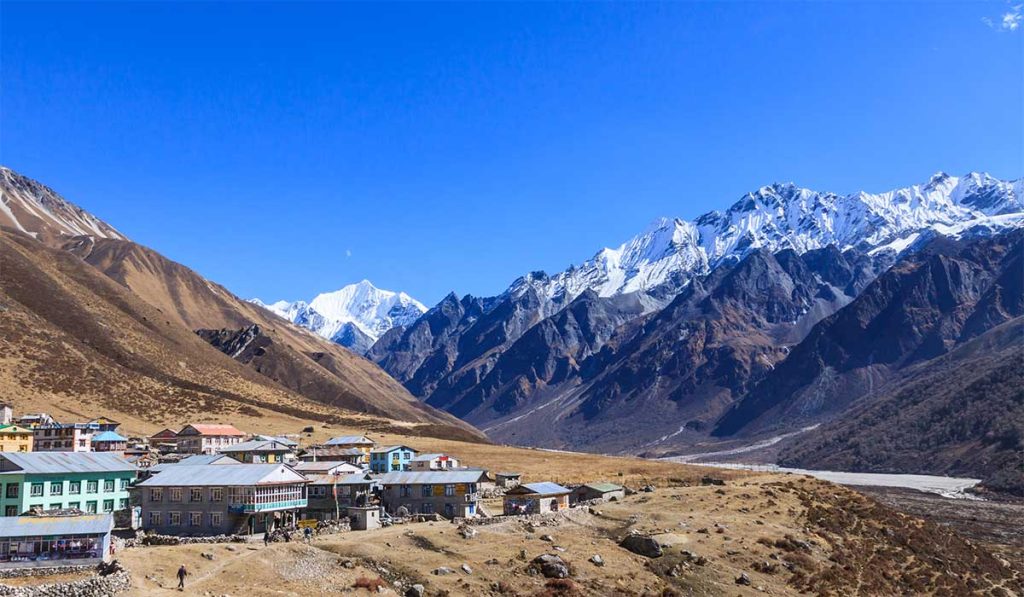
Introducing Langtang Lirung, Nepal
Langtang Lirung is slowly gaining popularity among climbers and nature admirers. This iconic peak was underrated for a long time because of the mindblowing Nepali landscape where a lot of majestic peaks and Himalayan ranges are present, including the highest one, Mt. Everest. Now, since mountain exploration has peaked, the Langtang Lirung can no longer hide from being appreciated.
Langtang Lirung peak is the highest one in the Langtang range. It rises above the skies at 7,227 meters (23,711 feet). It is just 60km away from the capital city Kathmandu and lies in the Langtang National Park. It is easier to reach and even less crowded than Everest or Annapurna. Due to this, the Lirung provides the trekkers a peaceful and worthwhile time in Nepal’s Himalayas.
Are you eager to visit the Langtang Lirung peak? Even if you are not a climber, the Langtang Valley trek can bring you up close to this Natural wonder. This blog is prepared with the objective of providing every possible detail that an adventurous soul seeks.

Langtang Lirung at a Glance
| Category | Facts |
| Location | Langtang region, north-central Nepal |
| Elevation | 7,227 meters (23,711 feet) |
| Mountain Range | Langtang Himal (a sub-range of the Himalayas) |
| First Ascent | 1978, by a Japanese expedition led by Seishi Wada |
| Coordinates | 28°13′N 85°30′E |
| Climbing Difficulty | Technically challenging |
| Nearest Town | Syabrubesi |
| Notable Feature | Seen from the Langtang Valley, instantly identified by its unique pyramidal appearance, highest in the range |
History of Langtang Lirung and Langtang Valley
The history of Langtang is the story of nature, culture and adaptation. People living in the Langtang region have known Langtang Lirung mountain for centuries. For them, Langtang Lirung is not only a physical milestone, but also a sacred place. Still today, the local people believe that the mountain is protected by powerful spirits and gods. You may have seen the colorful flags hanging in the temples nearby. These are the ways they honour the Langtang Lirung mountain.
The name “Langtang” means “Mountain Pass” in Tibetan language. The valley and mountains have been part of trade and cultural exchange routes between Nepal and Tibet for centuries. People used these paths to trade salt, wool and other goods.
For centuries, the region was a calm and remote area. Trekking here has became popular in the late 1900s and climbing just in late 20th century. In 1976, Nepal declared the country’s first Himalaya National Park, Langtang National Park. This initiative was aimed at protecting the environment, forests and wildlife in the Langtang region. It also helped preserve the culture and traditional method of living.
Today, Langtang Lirung and the Valley attract trekkers and nature lovers from all over the world. Despite this, the region still maintains its peaceful and traditional charm.

Culture and Spiritual Significance of Langtang Lirung
The Langtang region is the home of the Tamang people. They are the main community living in this valley. Tamangs have their own language, customs and life. They are known for their warm and welcoming nature.
Tamang’s culture is strongly influenced by Tibetan traditions. Their language is similar to Tibetan. They wear warm woolen clothes and handmade jewelry. Their diet includes dishes such as Tibetan bread and momos (dumplings).
Buddhism is the main religion here. You will see many Buddhist monasteries, flags and mani walls along the trekking trails. The mani walls are long stone walls carved with prayers. If you go for a visit, always remember to move around the stupas in clockwise direction as a sign of honor.
There are also many local festivals associated with mountains and Buddhism. These festivals include prayer ceremonies, dances and rituals honoring the gods that are believed to protect the region. During these events, rural monasteries light butter lamps and candles.
For Tamang people, the Langtang Lirung mountain is more than just a normal mountain. It is regarded as sacred and is directly connected with their faith. This spiritual belief adds a special attraction to the valley and makes it feel peaceful and pure for visitors.
Trekking route to see Langtang Lirung
Langtang Valley Trek is the best way to experience the beauty of Langtang Lirung if you are not on a climbing expedition. This route goes through scenic landscapes, traditional villages and quiet trails. The basic route will normally take 6–8 days of trekking over 60–75 km. Here are some of the popular places that lie on the way to Langtang Valley.

Syabrubesi
Syabrubesi is a small town by the river surrounded by green hills. It is the starting point of the trek. Many people spend a night here before they start the journey. It has shops, hotels and a peaceful village atmosphere.
Lama Hotel
Located deep inside a forest, Lama Hotel is a cool resting place on the path. It is surrounded by big and tall oaks, pines and bamboo trees. This area feels calm and closer to nature, making it an ideal stop to spend time relaxing before climbing higher.
Langtang Village
A traditional Tamang Village with stone houses and narrow trails. The village is full of cultural attractions and offers the first fantastic view of Langtang Lirung. You can see local people working in the fields and grazing yaks in the open mountain.
Kyanjin Gompa
One of the main attractions of the trip, Kyanjin Gompa, is a beautiful village surrounded by snow -covered peaks. It is home to the old Buddhist monastery and even has a small cheese factory. From here, Langtang Lirung looks close and clear, making it an ideal place for photography.
Kyanjin Ri
Kyanjin Ri is a popular stop near Kyanjin Gompa. The ascent of Kyanjin Ri is small, but steep. From above, you can see Langtang Lirung beautifully shining, especially during sunrise or sunset.
Tserko Ri
A higher viewpoint that provides a wide panorama of the Langtang range, glaciers and deep valleys. This is perfect for trekkers who want to see more dramatic mountain scenes and enjoy cool, quiet and open places.
Langshisa Kharka
Langshisa Kharka is a peaceful alpine meadow located further into the valley. It is surrounded by towering peaks and glaciers. This place is less crowded, giving trekkers a feeling of solitude and closeness to nature.
Langtang Lirung Expedition: Everything You Need to Know
Langtang Lirung peak has remained a challenging and low-climbed peak since years. Unlike famous mountains such as Everest or Annapurna, it does not see many climbers every year. This is because the Langtang Lirung expedition requires advanced technical skills, experience and careful planning to climb.

Langtang Lirung Climbing History
The first attempt to climb to the top of Langtang Lirung was in the early 1900s. However, the technical difficulty and tough weather in the Langtang Lirung mountain made it very challenging. Many preliminary campaigns had to turn back before reaching the top.
Finally, in 1978, a Japanese campaign team managed to climb Lirung for the first time. This was a great achievement in the history of mountain climbing. The team met many dangers, including steep ice walls, crevasses and sudden storms. This successful Langtang Lirung expedition inspired many other climbers to explore the region more.
Despite this, Langtang Lirung has an important place in mountaineering history. It represents the spirit of adventure and the beauty of the Himalayas. Today, climbers who try to summit the Langtang Lirung often use the same path as the first Japanese team.
Langtang Liring Climbing Route and Camps
Reaching the top of Langtang Lirung peak is not an easy task. This task is only for climbers with strong determination and prior experience. The typical climb follows the southwest ridge route, which is the fastest, safest, and efficient route. The journey starts from Kyanjin Gompa (3,870 m). It is a point of acclimatization. From there, climbers have to reach to the base camp and higher ones before summiting the peak. Here are each ones explained:
The Langtang Lirung Base Camp (4,300 m)
Langtang Lirung Base Camp is at around 4,300 meters altitude. It offers a remote Himalaya experience for its trekkers. It far quieter compared to Everest or Annapurna. This camp marks the beginning of the climbing journey for ambitious mountaineers targeting the peak.
Camp I (about 5,400 meters)
From the base camp, climbers ascend the rocky trails to reach Camp I. This camp is situated on a glacier and requires careful navigation. From here, climbers start to use ropes and crampons as the terrain becomes more icy and steep. Camp I is also used for further acclimatization. Some climbers go up and down several times to adjust to the thin air.
Camp II (about 6000 meters)
The route to Camp II is more technical. Mountain climbers will cross the icy and rocky combined section. Here, one must have the skills of harnessing or using a fixed rope to ensure safety. Camp II is small and colder, but climbers start facing the strong winds that are common at such an altitude.
Camp III (approx. 6,500 m)
Camp III has been set up on steep icy slopes and is very close to the top. It is the highest camp, and the conditions here are extremely cold and windy. The oxygen level is very low, making any movement slow and tiring. Langtang Lirung mountain climbers usually relax shortly here and prepare the gear for the final Summit Push.
Summit Push (7,234 m)
The Langtang Lirung Summit Push has to start very early, often at midnight or around 01:00 AM. This benefits the climbers to reach the top in the morning when the weather calms down. The route presents steep ice climbing, crevasse crossings, and fixed rope sections. It’s totally narrow and steep, but that’s what makes it the greatest of its range. It’s like the peak saying, “If you want to stand above me, defeat me first.”
Well, when you succeed in your mission, you will be rewarded by the breathtaking views of the Langtang range, Shishapangma, and even parts of Tibet. And moreover, a sense of true accomplishment that’s forever yours.

Top Reasons Why Langtang Lirung Should Be on Your List
- The Himalayan scenery that Langtang Lirung provides feels truly raw and deeply rewarding.
- Being close to the capital city gives you easier access to Himalayas without additional days of travelling.
- The quiet, calm and peaceful trails provide a perfect getaway from the busy city life.
- You’ll get kind hospitality from Tamangs and other local communities that will be worthy to remember.
- The topography is diverse, which makes you walk from lush green trails to rhododendron forests in the beginning days and to the icy glacier in the ending days.
- You can spot some of the rare wildlife and birds that are seen only in the Himalayas. This includes Thars, red pandas and Himalayan monals.
- Visiting Kyanjin Gompa gives you history and taste and climbing Kyanjin Ri or Tserko Ri gives you breathtaking panoramas.
Additional Important Info

Best Time to Visit
Wondering what is the best time to visit Langtang Lirung? They are surely the spring and autumn. The spring season stretches from March to May. During this time, the weather is warm and clear. The forests and hills are filled with colored rhododendron flowers. This makes the trails beautiful. It is also a great time to see wildlife and enjoy fresh mountain winds.
Autumn starts from September and stays till November. This time is the peak trekking time in Nepal. In autumn, the sky is usually clear and offers fantastic views of Langtang Lirung and other peaks. The air is fresh and cool, and the weather is stable, making the hike comfortable and safe.
Winter, from December to February, can be too cold with snow that covers high trails. While fewer trekkers travel during this time, people who like calm and icy landscapes may find it special. However, due to snow, some sections can be tough to trek.
The monsoon season generally comes in the last option. For most of the trails, this is the most avoided time. Usually beginning in June and lasting until August, it brings heavy rain, slippery paths and low visibility due to fog.
In short, spring and autumn give the best weather, visuals and trekking experience in the Langtang region.
2015 Earthquake and Langtang Recovery
In April 2015, Nepal was hit by a heavy earthquake that caused a lot of damage throughout the country. Langtang Valley was one of the hardest hit places. A large avalanche came down from Langtang Lirung and destroyed most of the village. Sadly, many people lost their lives. Houses, shops and cabins were buried under snow and stones.
After this tragic event, the people in Langtang showed incredible power and courage. Many local communities, various organizations, and the government itself contributed. Finally, the village was rebuilt from scratch. Now, new teahouses, schools and trails have been rebuilt, and the valley is now safe for visitors.
When you trek in the Langtang Valley, the local families get a chance to earn. They rely on tourism to rebuild their lives. So, by traveling here, you not just enjoy fantastic nature and culture, but also contribute to the future of this society.
Permits Required for Langtang Region
If you are planning to travel to Langtang, whether for trekking or climbing, you must have some permits according to Nepal’s Climbing rules.
For trekkingThe main permit is the Langtang National Park entry permit. This permit allows you to enter the national park and the trek in the Langtang region. It costs about 3000 NPR for foreign visitors. This permit fee helps to protect the park’s wildlife, forest and natural beauty.
You can get the permit by visiting the Nepal Tourism Board Office in Kathmandu. If you travel with a reliable and authorized trekking agency, they generally handle all the permit-related headaches.
For Climbing Langtang LirungLangtang Lirung expedition is technical and challenging, so the permit process is stricter. You need a Langtang Lirung mountain climbing permit issued by the Nepal Tourism Board. The permit costs depend on the size of your team and season, but it can be several thousand dollars. You must also submit a detailed climbing plan and hire authorized guides and support staff.
Travel Insurance Travel Insurance is not a permit. It is non-mandatory as well, but very important while entering higher altitudes. Your package ( Langtang Lirung trekking / Langtang Lirung expedition) may also not cover its fee as it’s optional. However, this insurance covers the medical expenses for any unfortunate injury, sickness and emergency evacuation (even the helicopter evacuation).

Conclusion
The trip to Langtang Lirung gives you much more than just a trek. It thrills you by taking you through several challenging sections, delights you by showing the colourful forests, and calms you with the peaceful trails away from the crowd. It gives you a chance to experience Tamang culture, share smiles with the locals and stay in comfortable tea houses with food of a home-cooked taste. Moreover, it even gives you satisfaction knowing that your journey helps a society that has been rebuilt with courage and strength.
If you are joining the Langtang Lirung expedition, it not only tests your endurance and dedication but also rewards you with the pure beauty of nature. Unlike other journeys, you’ll not only get adventure but also a purpose. And that’s the best part of this unforgettable journey.
So, when are you coming? Langtang Lirung is waiting for you.

